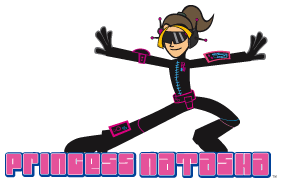Alain Bielik rides along with the visual effects artists on The Fast and the Furious: Tokyo Drift for a trip to a virtual Japan.

KOL, AOLs site for kids, has offered original animation since its launch. Princess Natasha is one of its half dozen core properties. © AOL.
A growing number of viable forums exist for independent animators to generate exposure on the Web, whether through animation-specific portals, on general entertainment sites, or virally. Even more important, there is ever-greater potential for animators to make money from their online productions.
In some cases, portals are similar to broadcast or cable networks in that they have relatively few slots available for original content. AOL is one example. Its KOL site for kids has offered original animation since its launch, but it focuses on just a half dozen or so core properties, including Princess Natasha and Kung Fu Academy, mostlysourced from Animation Collective. The service recently introduced a preschool series, Pilars Adventures (for KOL Jr.), and acquired a property called Joseph Two-Two from Nelvana. Its teen area, AOL RED, features a section called Chubby Butter, also from Animation Collective, that highlights humorous animated shorts; an original series for teens is in development as well.
Were inundated by producers and animators wanting to work with us, says Malcolm Bird, AOLs svp of kids and teens programming. Weve got the platform and the audience and the eyeballs. But how many deals can you do before you dilute the platform? We see a lot of really cool stuff, but we cant use it all.
Icebox is another site that plans to be selective when it relaunches this year. Currently, the site features only material produced by Icebox, which lately has been focused on selling some of its 21 proprietary properties (encompassing 170 shorts) to other companies. Iceboxs Queer Duck is about to come out as a direct-to-video film, while Mr. Wong has appeared on DVD and in various online environments.
Flash animation gives everyone access to the technology, but it doesnt mean everything is good, says Tal Vigderson, managing director at Icebox, who says the new Icebox portal will focus on a few properties that stand out and have franchise potential. The original incarnation of the site featured a section called Icebox Independents, with content solicited from independent animators, and something similar will probably be included in the new version. Its a neat way to find new talent, Vigderson comments.

Malcolm Bird, AOLs svp of kids and teens programming, reports that hes inundated by producers and animators wanting to work with the company, but unfortunately, cant use it all.
Other sites accept a greater amount of content, with the goal of having as much variety as possible. Atom Ent.s AtomFilms.com, which launched in the late 1990s, offers a broad spectrum of animated and live-action shorts, including submissions from brand-name studios such as Aardman and JibJab as well as relatively unknown independents. All told, it has more than 1,000 films (one to 30 minutes in length) available for on-demand viewing.
Heavy, which also debuted in the late 1990s, features live-action and animated content that is a mix of 50% internally generated or acquired content and 50% user-generated content. Selected properties include Behind the Music That Sucks, which is produced by Camp Chaos, and Heavy News, a new series in development with producer City Lights. Several series picked up from independent studios will launch in the third and fourth quarters of 2006.
All of Heavys content fits its mission of providing entertainment, mainly comedic, for men, 18-34. Our point of view makes us different from the throngs of other entertainment outlets online, says David Carson, Heavys co-ceo/co-founder.
Carson notes that things have changed since Heavy launched in 1999. There was a lot of interest in putting money behind [online animation] then, but no good distribution outlets for it, he says, pointing out that one million downloads made for an enormous hit at that time. Now there are some really good outlets that rival cable. I have an audience the size of Comedy Centrals. Heavy boasts about six million viewers monthly.
User-Generated Content
A recent development is the burgeoning popularity of user-generated content, where web users of all types can upload their own live-action or animated clips, essentially unfiltered by any gatekeeper. (There may be some screening to ensure content fits within a sites demographic target or because of bandwidth limits.) Sites such as YouTube which delivers more than 40 million live-action videos a day, with 35,000 new clips uploaded daily have brought this phenomenon into the mainstream. Many entertainment portals have added mechanisms where users can upload video or animation to share with other users, enhanced by MySpace-style social networking elements.
One subcategory of user-generated content is Machinima, where fans create original animation by editing clips recorded from videogames and adding new audio tracks. Machinima.com specializes in this type of content, distributing more than 2,000 user-generated Machinima videos as well as developing and producing original and for-hire Machinima. The site provides tools and resources for users who want to make their own content.

Icebox will relaunch later this year. Lately it has been focused on selling some of its proprietary properties, including Queer Duck, about to come out as a direct-to-video film. © 2000 Mishmash Media/Icebox Inc.
Machinima.com aggregates Machinima films into channels tied to specific games. The Halo channel, launched in May 2006, served more than 1.4 million videos just during beta testing. Other current channels on the site include World of Warcraft, Sims 2, F.E.A.R., Half-Life 2, Unreal Tournament, Everquest 2 and Quake.
Although bandwidth considerations have made it impossible for every submitted Machinima to be uploaded, the company hopes to be able to open the site up to all user content soon, as well as adding social networking and other features. Its a great way [for fans] to finally realize that idea they always wanted to make, says Philip DeBevoise, president of Machinima.com. Thats why were here. To help them take a fantastic idea that in traditional media may never be realized, and bring it to life.
Heavy also features user-generated Machinima, including Red vs. Blue, based on Halo. It also produces Machinima, recently debuting a new series, Pimp My Weapon, done for Sony to help promote its God of War franchise. Pimp attracted nine million streams very quickly, according to Carson. Tourettes Cowboy and Gangster Nanny 911 are other examples on Heavy, which ran a whole season of Machinima last November consisting of three to eight episodes each of eight different shows.
Atom has gotten into user-generated content with the launch of AddictingClips, a sister site to AtomFilms.com and AddictingGames, which Atom purchased in November 2005. Consumers can upload and share video, animation and games, and a Cash for Clips program allows the best creators to win prizes and further distribution on AtomFilms. AddictingClips, which is one of a relatively few user-generated portals where viewers can upload Flash productions, receives four to five million visitors per month.
This viral content is a big draw, says Scott Roesch, vp/gm of AtomFilms and Addicting Clips. He points out that the company sees AddictingClips more as a driver of traffic to its other sites rather than as a standalone business. It also may be able to mine the site for content with franchise potential. But Roesch cautions that screening content on the front end would fly in the face of what user-generated sites are all about. These have to be passive conduits, he says. The company can look at viewership numbers and feedback once a clip is posted. Its an audience-driven success metric that might help us find that diamond in the rough.

Heavy features live-action and animated content that mixes internally generated, acquired and user-generated content. Selected properties include Behind the Music That Sucks. © Heavy.
Heavys Carson believes viewers can relate to content created by other viewers, noting that the clips with the worst production values often are the most popular. They seem to like the homemade stuff, he comments. Quality seems to be in the eye of the beholder.
User-generated has changed the nature of what youre making [in terms of online content] in general, Carson adds, explaining that all clips are on the same footing, no matter the budget. Money doesnt necessarily equal popularity.
A new user-generated site is aniBOOM, a broadband animation hub that features original animation, the aniBOOM Awards and content creation tools. Animators can create their own mini site and upload films up to 15 minutes long. Already the site has attracted shorts from professionals, amateurs, independents and students, according to Ramy Romanovsky, project director. Since we are targeting our services and activity toward the professional animation industry, the majority of films are high quality, he says. However we do not filter any kind of content, and the website is open for submissions of all types of animations from filmmakers of all skill levels.
Users rate and comment on the films, and content creators receive stats on ratings and viewership levels. Cash prizes are available for films that are highly rated by viewers. The site also plans to add some internally generated original content, although the focus is on providing a forum for users to share their creations.
Revenue Opportunities for Animators
While many sites primarily give animators the means to promote their properties, others increasingly are offering animators a share of revenues. The percentage varies from company to company and from deal to deal.
Atom has paid for content since the beginning, giving animators a royalty on advertising, distribution and other income generated from their properties. While some animators make a small amount, top creators can generate hundreds of thousands of dollars. Weve paid millions and millions out, Roesch says. Many sites offer the opportunity to post on the Web for exposure, but we offer career and revenue opportunities.

All of Heavys content fits its mission of providing entertainment, mainly comedic, for men, 18-34. The portals David Carson reports that it has an audience the size of Comedy Centrals.
Icebox will offer a combination of exposure and revenue-sharing. Initially creators will simply get a forum, but if their property becomes popular and is able to generate further revenues, they will share in any ongoing income streams, according to Vigderson.
Although some sites have been paying for content as long as seven years now, there still is no standard compensation model for revenue-sharing between distributors and content providers. It all boils down to the perceived future value of a specific property. How much do you want it and what can you do with it as a business?, asks Carson.
One company, Revver, has developed a revenue-sharing mechanism for user-generated content. Were a service that monetizes content that moves freely across the network, says Steven Starr, the companys founder/ceo. The service gives creators data on where their content is viewed, whether on websites, viral e-mails, social networking sites or blogs. Each clip is matched up with an advertisement, which appears with the clip wherever it is viewed; content providers receive half of all revenues paid by the advertisers on a click-per-view basis. Creators can set parameters for the type of advertisers they want to be linked with, and advertisers have the same ability to select or refuse content. Currently, ads take the form of still images at the end of each clip, but other formats, such as pre- and post-roll video, are expected to be added in the future.
The Revver network just came out of beta testing recently, but it already has a hit, the live-action video, The Diet Coke and Mentos Experiment. Creators Fritz Grobe and Stephen Voltz of studio Eepybird have earned nearly $20,700 on the clip, which has attracted more than three million total views. Its proof that the model works, says Starr. Were aligned with the way the Internet was built to begin with. [Creators] can benefit from the freely distributed platform that the Internet was meant to be.

A new user-generated site is aniBOOM, a broadband animation hub that features original animation, the aniBOOM Awards and content creation tools. © aniBoom.
A lot of creators are frustrated with seeing their creative work distributed on the Web and they dont have any control over it. But they do see the value of viral distribution, adds Bill Jeffries, Revvers vp of network development. We try to give all the control to the creator.
Investing in Content
Several portals are beginning to invest in promising productions upfront and partner in their development, similar to a television network. The ultimate is that we pay you to make your cartoon, says Bird, who stresses, however, that a portals budget is only so big and just a few properties can capitalize on this model.
Break.com, an online network for men that boasts 13 million unique monthly visitors, launched Break Ent. in April 2006 to incubate original online videos, which it will do in addition to acquiring and licensing content. Similarly, both aniBOOM and Machinima.com provide financing in some cases. We want to find great talent and, as a production company, to work with them to develop their ideas, Machinima.coms DeBevoise explains.
Atom announced the opening of AtomFilms Studios in January to invest in independent productions. It said it had six new development projects at that time and that it planned to produce dozens of additional properties during the year. They will be distributed on AtomFilms.com and through the companys partners in the online and mobile arenas.
Roesch points out that as portals launch and go through their early growth stages, they need to share risk with their creators, which a licensing model allows. But Atom and some other sites have been in business long enough now that that they can predict revenues fairly accurately and know what they can afford to invest upfront.
Revenue Streams
In order for portals to pay creators, whether through royalties or investment, there have to be revenue streams that are large enough to share. That is starting to be the case for many sites, which are generating revenues from online and mobile licensing, advertising and sponsorships and, sometimes, entertainment productions or merchandise licensing. Subscriptions are a possibility as well, although the most common configuration now is for sites to offer advertiser-supported content that is free to consumers.

KOL, Jr. recently introduced the preschool series, Pilars Adventures. © AOL.
The relative strength of each of these revenue sources varies by site, and can evolve over time for individual sites as well. Roesch says Atoms revenues in the late 1990s were mostly from licensing to other websites, but these days, with five to six million unique users a month, the company focuses primarily on advertising and sponsorship, with licensing limited to a handful of partners.
Advertisers are increasingly interested in having a presence on entertainment portals and even in supporting user-generated content, although some are leery of the uncontrolled nature of the medium. Atoms ad salespeople, for example, have seen interest from various companies in sponsoring AddictingClips, according to Roesch.
DeBevoise says game publishers are interested in promoting user-generated Machinima based on their games, both as a way to drive sales of the game itself and to add value for fans. Blizzard mentions Machinima.coms World of Warcraft channel on its website, while Universal Games links to the F.E.A.R. channel. In June, the site launched a contest with Intel that allows fans to submit ideas for a three- to five-minute Machinima movie the proposal could be a script, video pitch or clip with the winner making the film with Machinima.coms team. Intel and Activision also provide prizes.

Steven Starr of Revver, has developed a revenue-sharing mechanism for user-generated content. Content providers receive half of all revenues paid by the advertisers on a click-per-view basis.
Heavy ran a similar contest for sponsor Burger King, where 25 content creators were paid to make original videos featuring the well-known masked King from the chains TV commercials. Some were bad and some were really, really good, Carson says, noting that consumers viewed well over 20 million streams in the first few weeks of the contest, with two of the submissions proving especially popular.
The Revver service attaches advertising to user-generated clips, as noted earlier, splitting revenues 50/50 with the creator. The service also is developing tools for sponsors to set up animation film festivals or contests for user-generated content, either on the advertisers site or in a standalone environment.
Mobile Content, Merchandise and Entertainment
Online portals are more often licensing their content for distribution on mobile and other portable and alternative platformscell phones, PlayStation Portable, iTunes, Xbox Live! which brings in subscription revenues or transaction fees that, once shared, add to creators revenue potential. This is an income stream that wasnt available in the portals early days. Theres a whole new market for short-form animation clips, says Vigderson. Theres money out there, partly because there are these new venues.
Heavy has deals with Verizon and Sprint, while Atom launched AtomFilms To Go, which enables consumers to download content for platforms such as the PSP and the iPod. It also has a deal with Verizon for a mobile channel called AtomFilms Studio Originals.
In addition to bringing in revenue, mobile distribution is a way for a portal to solidify its brand image. Were interested in extending our brand to be a multiplatform brand, DeBevoise says. We want to be the brand for Machinima in all platforms.

Revvers Bill Jeffries notes that many creators are frustrated by the lack of control they have over creative work, which is distributed on the Web. Revver tries to give all the control to the creator.
Theres a lot of overlap between what works online and on mobile, reports Roesch. Atoms Star Wars Gangsta Rap is among the most popular clips both online and on its Verizon channel. Still, not all preconceptions about what works on mobile platforms are correct. For example, conventional wisdom says the shorter the mobile clip, the better, yet Atoms second most popular film on the mobile platform so far has been 11 minutes long. That said, the company is thinking of developing some very short, episodic (perhaps even daily) mobile-only content in addition to its mobile-distributed online offerings.
As viewership numbers for online entertainment portals grow, the possibility exists for merchandise licensing and entertainment productions. Iceboxs Queer Duck, which has been on Showtime as well as online, will come out as a direct-to-video movie from Paramount in July, while AOLs Princess Natasha appears on Cartoon Network.
As for licensed products, AOL has signed more than 22 licensees for Natasha, the most popular original cartoon on KOL and one of the most popular of its over 200 games. Books are in stores, a DVD is coming out in August and other products will debut in the fourth quarter of this year and the first quarter of next.
Its a numbers game, says Bird, who notes that licensees are impressed not only with the more than 3.5 million kids who have watched Natasha online, but by how they interact with it and watch it over and over. Both of these factors, which are unique to the online environment, help spur demand for merchandise.
Karen Raugust is a Minneapolis-based freelance business writer specializing in animation, publishing, licensing and art. She is the author of The Licensing Business Handbook (EPM Communications).







